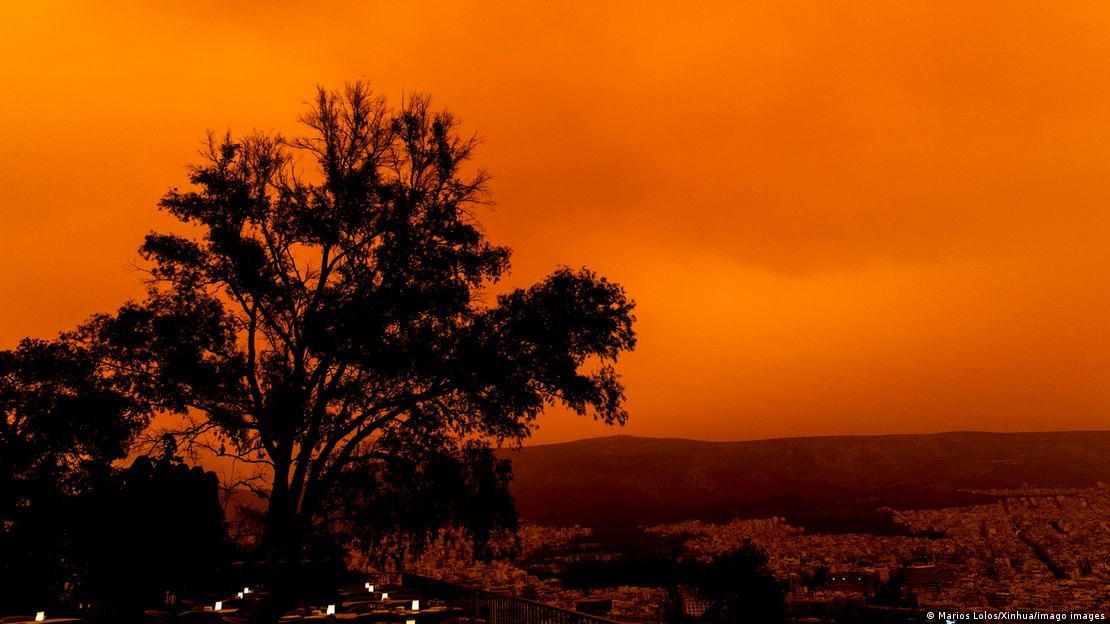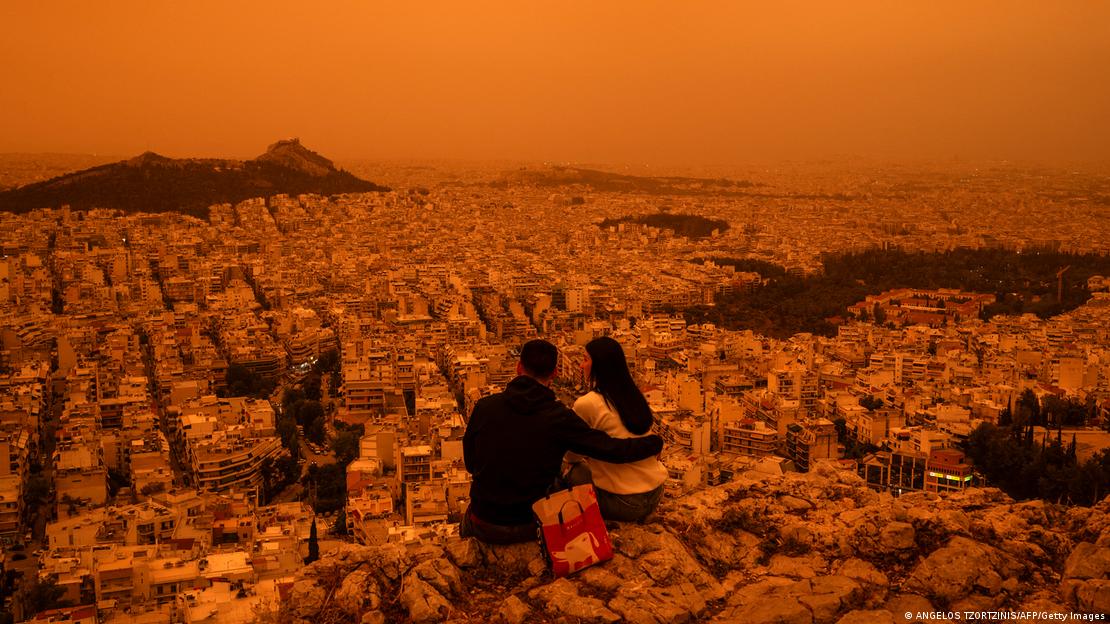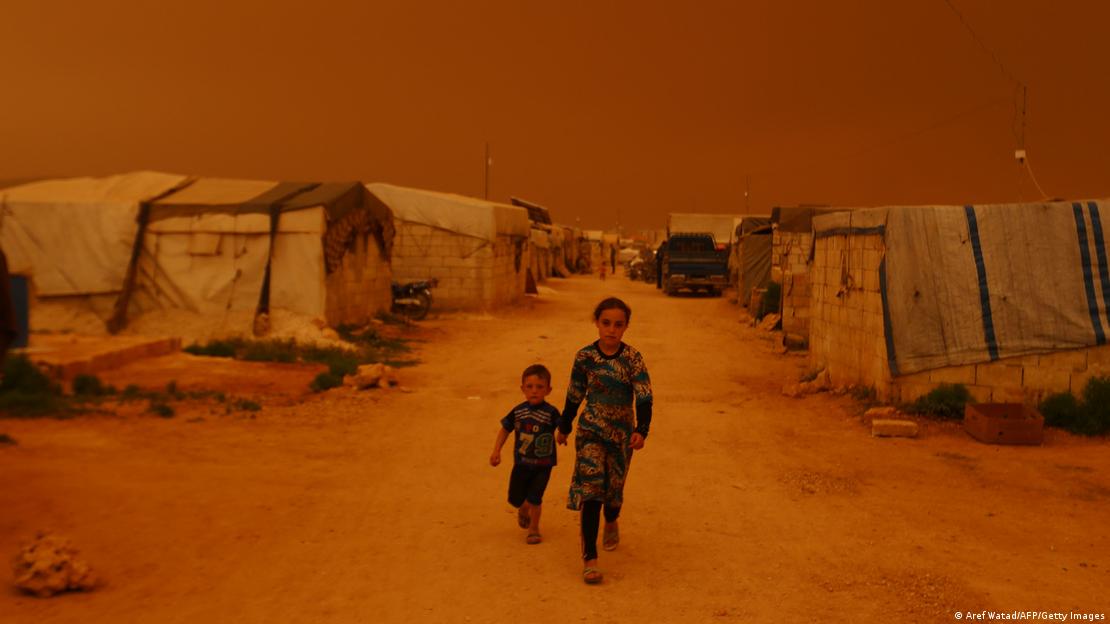Dust storms that carry particles from the Sahara into European capitals are more common than you'd think. Here's what you should know about them and how to keep yourself safe.
Clare Roth
April 26, 2024
DW
The dust storm that hit Athens on April 23 gave the city a red tint
Costas Baltas/Andalou/picture alliance
Dust from the Sahara blew thousands of miles to Athens, Greece, this week, resulting in a striking natural event that appeared to position the Acropolis, at least momentarily, on Mars, giving everything a reddish-orange tint.
Storms that carry dust from the Sahara into European capitals are common and have been happening for years. Here's what you should know about how they form, how they move and whether they present a risk.

Dust from the Sahara blew thousands of miles to Athens, Greece, this week, resulting in a striking natural event that appeared to position the Acropolis, at least momentarily, on Mars, giving everything a reddish-orange tint.
Storms that carry dust from the Sahara into European capitals are common and have been happening for years. Here's what you should know about how they form, how they move and whether they present a risk.

Athens was shrouded in orange dust this weekImage:
Marios Lolos/Xinhua/imago images
How does a dust storm develop in the Sahara?
Dust storms occur when high winds blow through the Sahara Desert, which stretches across northern Africa, in dry conditions. The sands of the desert are made up of many different particles, Carlos Perez Garcia Pando, a sand and dust expert at the Barcelona Supercomputing Center, told DW.
Some particles are large and heavy. These are the first particles picked up with high winds, but they are not the ones that will ultimately blow their way over the Mediterranean Sea to Europe.
Rather, when these larger particles inevitably drop to the ground, their impact breaks up other clumps of sand, dispersing into ultra-small dust particles, said Garcia Pando. These smaller particles are the ones that ultimately blow long distances, because they are so tiny and light.
The conditions need to be dry in order for these storms to occur, because otherwise particles clump together and become too heavy to fly long distances. Sandstorms are most likely to pick up in areas where there is little vegetation, which could interact with the wind and slow a storm down.

Sand and dust storms are common in the Sahara DesertImage: Charlie Bristow/REUTERS
Why are these storms bringing dust to Europe?
Dust storms occur regularly in the Sahara Desert. But in order to blow thousands of miles north, these storms need to interact with a weather system that will provide the strong winds necessary to push them long distances.
In most cases, a low pressure weather system transports Sahara dust over the Mediterranean to Europe. These systems are energetic, Garcia Pando said, and exert strong winds counterclockwise. They typically occur in spring. High-pressure weather system can also cause these events, but that's less likely.
The dust particles that ultimately fly to Europe are able to stay in the air for so long because they're much smaller than sand, which falls out of the air much faster, Stuart Evans, a dust expert at the University of Buffalo in New York, told DW in an email.
"What arrives in Europe is a dust storm but not a sand storm," he said.

Why are these storms bringing dust to Europe?
Dust storms occur regularly in the Sahara Desert. But in order to blow thousands of miles north, these storms need to interact with a weather system that will provide the strong winds necessary to push them long distances.
In most cases, a low pressure weather system transports Sahara dust over the Mediterranean to Europe. These systems are energetic, Garcia Pando said, and exert strong winds counterclockwise. They typically occur in spring. High-pressure weather system can also cause these events, but that's less likely.
The dust particles that ultimately fly to Europe are able to stay in the air for so long because they're much smaller than sand, which falls out of the air much faster, Stuart Evans, a dust expert at the University of Buffalo in New York, told DW in an email.
"What arrives in Europe is a dust storm but not a sand storm," he said.

Officials said the Athens dust storm was one of the worst to hit Greece since 2018Image: ANGELOS TZORTZINIS/AFP/Getty Images
Are these dust storms a problem?
"This has happened repeatedly throughout history, dust is almost as old as the Earth," said Garcia Pando. "It's nothing new."
He explained that analyzing these dust storm events is not about stirring up fear. Rather, he said, it's about understanding the phenomenon and what it represents for society and the climate. Dust, he explained, is not always a bad thing: For example, it serves as a sort of nutrient to forests and oceans, feeding them iron and phosphorus.
The amount of dust on Earth has been increasing since pre-industrial times, Garcia Pando said. This is largely due to human cultivation of land, but also the changing climate.
To explain how this works, he said to imagine a piece of crusted up dirt. If you step on the dirt, or a car runs over it, tons of particles or dirt break loose, and "all those particles are more easily affected by wind."
With climate change, he gave the example of water sources that dry up in response to a drought. Once a lake has dried up, he said, "the sediments that remain in the lake are very, very erosive and can be emitted very easily to the atmosphere."
But at this point, scientists still aren't sure whether climate change will cause more or less wind on Earth, so it's hard to say what the future of dust storms may be.
"This is one of the key uncertainties that we have in projecting the future of the dust," Garcia Pando said. "Understanding how winds in different situations will evolve — not only the average wind, but also the extremes."

Sahara dust storms also make their way to other countries, like SyriaImage: Aref Watad/AFP/Getty Images
Stay safe in a dust storm
If you find yourself caught in a dust storm in Europe, Garcia Pando said you should follow the same advice given by experts on days when air quality is particularly low. Dust is a respiratory hazard, so wear a mask and abstain from outdoor sport activities. This is particularly true for people with respiratory diseases.
Edited by: Carla Bleiker
Stay safe in a dust storm
If you find yourself caught in a dust storm in Europe, Garcia Pando said you should follow the same advice given by experts on days when air quality is particularly low. Dust is a respiratory hazard, so wear a mask and abstain from outdoor sport activities. This is particularly true for people with respiratory diseases.
Edited by: Carla Bleiker

No comments:
Post a Comment